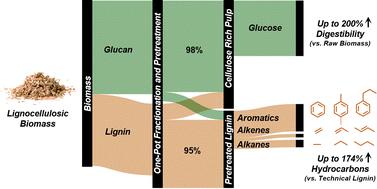当前位置:
X-MOL 学术
›
Energy Environ. Sci.
›
论文详情
Our official English website, www.x-mol.net, welcomes your
feedback! (Note: you will need to create a separate account there.)
An effective strategy to produce highly amenable cellulose and enhance lignin upgrading to aromatic and olefinic hydrocarbons
Energy & Environmental Science ( IF 32.4 ) Pub Date : 2022-10-24 , DOI: 10.1039/d2ee02304k Daniel Vincent Sahayaraj 1, 2 , Lusi A 3 , Andrew J. Kohler 1, 2 , Hamed Bateni 1, 2 , Harish Radhakrishnan 3 , Alireza Saraeian 1, 2 , Brent H. Shanks 1, 2 , Xianglan Bai 3 , Jean-Philippe Tessonnier 1, 2
Energy & Environmental Science ( IF 32.4 ) Pub Date : 2022-10-24 , DOI: 10.1039/d2ee02304k Daniel Vincent Sahayaraj 1, 2 , Lusi A 3 , Andrew J. Kohler 1, 2 , Hamed Bateni 1, 2 , Harish Radhakrishnan 3 , Alireza Saraeian 1, 2 , Brent H. Shanks 1, 2 , Xianglan Bai 3 , Jean-Philippe Tessonnier 1, 2
Affiliation

|
Lignin is a promising renewable feedstock for the production of valuable phenolic and hydrocarbon building blocks. However, the economic viability of lignin upgrading strategies has so far been hampered by the recondensation of primary products and the preferential formation of char over bio-oil. Here, we demonstrate that lignin pretreatments effectively lower char formation and enhance carbon volatilization during pyrolysis. Various solvolytic and catalytic pretreatments were investigated using sub- and supercritical ethanol and supported metal catalysts. By combining GPC, GC-FID/MS, elemental analysis, HSQC NMR, and TGA, we decoupled the effects of solvolytic and catalytic steps and identified their independent roles on chemical modifications relative to the parent lignin. The pretreatment step enhanced the production of volatiles and concurrently reduced char formation during fast pyrolysis, from 58 C% to 9 C% for lignin deconstructed at 250 °C using Pd/C. The strategy was then extended directly to lignocellulosic biomass (corn stover, switchgrass, red oak) to fractionate and pretreat lignin in a one-pot approach. The lignin oil obtained from this process exhibited an excellent potential to be converted into platform chemicals. Upon catalytic fast pyrolysis of the lignin oil, 11–14 C% aromatic hydrocarbons were produced, while hydrodeoxygenation yielded 34–40 C% of aromatic hydrocarbons (50–56 C% total hydrocarbons). Similarly, the recovered carbohydrates-rich water-soluble fraction was subjected to hydrodeoxygenation and yielded 10–15 C% of aromatic hydrocarbons and 15–29 C% of C2–C6 alkenes (32–74 C% total hydrocarbons). Furthermore, the residual pulp recovered from this method was enriched in sugars and was three times more amenable to enzymatic hydrolysis than the parent biomass. This approach provides new opportunities for the selective and effective conversion of lignin into value-added chemicals and, thereby, enhanced carbon recovery, which is vital for implementing biomass as a feedstock for chemical manufacturing.
中文翻译:

一种生产高度顺应性纤维素并促进木质素升级为芳烃和烯烃的有效策略
木质素是一种很有前途的可再生原料,可用于生产有价值的酚类和碳氢化合物结构单元。然而,迄今为止,木质素升级策略的经济可行性受到初级产品的再浓缩和生物油优先形成炭的阻碍。在这里,我们证明木质素预处理有效地降低了焦化形成并增强了热解过程中的碳挥发。使用亚临界和超临界乙醇和负载金属催化剂研究了各种溶剂分解和催化预处理。通过结合 GPC、GC-FID/MS、元素分析、HSQC NMR 和 TGA,我们分离了溶剂分解和催化步骤的影响,并确定了它们在相对于母体木质素的化学修饰中的独立作用。预处理步骤增加了挥发物的产生,同时减少了快速热解过程中的焦炭形成,使用 Pd/C 在 250 °C 解构的木质素从 58 C% 减少到 9 C%。然后将该策略直接扩展到木质纤维素生物质(玉米秸秆、柳枝稷、红橡木),以一锅法分馏和预处理木质素。从这个过程中获得的木质素油表现出极好的潜力,可以转化为平台化学品。木质素油催化快速热解后,产生 11-14 C% 的芳烃,而加氢脱氧产生 34-40 C% 的芳烃(50-56 C% 的总烃)。同样,对回收的富含碳水化合物的水溶性馏分进行加氢脱氧,得到 10-15 C% 的芳烃和 15-29 C% 的 C2 –C 6烯烃(32–74 C% 总碳氢化合物)。此外,从这种方法中回收的残余纸浆富含糖分,并且比母体生物质更容易进行酶水解的三倍。这种方法为将木质素选择性和有效地转化为增值化学品提供了新的机会,从而提高了碳回收率,这对于将生物质作为化学品制造的原料至关重要。
更新日期:2022-10-24
中文翻译:

一种生产高度顺应性纤维素并促进木质素升级为芳烃和烯烃的有效策略
木质素是一种很有前途的可再生原料,可用于生产有价值的酚类和碳氢化合物结构单元。然而,迄今为止,木质素升级策略的经济可行性受到初级产品的再浓缩和生物油优先形成炭的阻碍。在这里,我们证明木质素预处理有效地降低了焦化形成并增强了热解过程中的碳挥发。使用亚临界和超临界乙醇和负载金属催化剂研究了各种溶剂分解和催化预处理。通过结合 GPC、GC-FID/MS、元素分析、HSQC NMR 和 TGA,我们分离了溶剂分解和催化步骤的影响,并确定了它们在相对于母体木质素的化学修饰中的独立作用。预处理步骤增加了挥发物的产生,同时减少了快速热解过程中的焦炭形成,使用 Pd/C 在 250 °C 解构的木质素从 58 C% 减少到 9 C%。然后将该策略直接扩展到木质纤维素生物质(玉米秸秆、柳枝稷、红橡木),以一锅法分馏和预处理木质素。从这个过程中获得的木质素油表现出极好的潜力,可以转化为平台化学品。木质素油催化快速热解后,产生 11-14 C% 的芳烃,而加氢脱氧产生 34-40 C% 的芳烃(50-56 C% 的总烃)。同样,对回收的富含碳水化合物的水溶性馏分进行加氢脱氧,得到 10-15 C% 的芳烃和 15-29 C% 的 C2 –C 6烯烃(32–74 C% 总碳氢化合物)。此外,从这种方法中回收的残余纸浆富含糖分,并且比母体生物质更容易进行酶水解的三倍。这种方法为将木质素选择性和有效地转化为增值化学品提供了新的机会,从而提高了碳回收率,这对于将生物质作为化学品制造的原料至关重要。











































 京公网安备 11010802027423号
京公网安备 11010802027423号